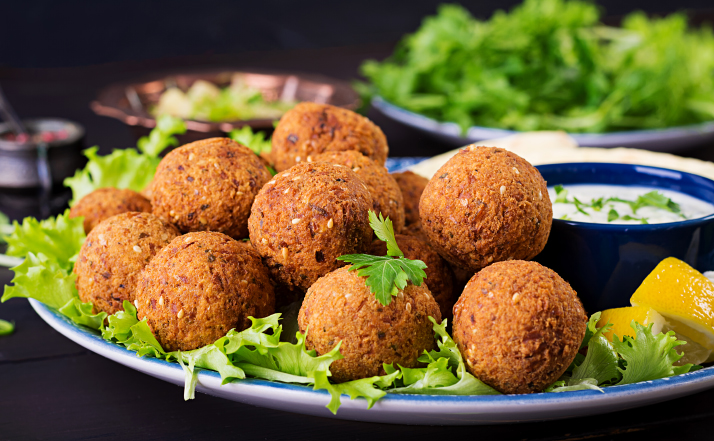| Lifestyle |
| Ta'meyya, the new old falafel | |
|
|
 Ta'meyya balls (VCG)
Whenever my Egyptian friends in Beijing and I get together, we won't stop ranting about being stuck with no prospects of visiting home in the foreseeable future, thanks to COVID-19-related travel restrictions and quarantine measures. Of course, it goes without saying that we miss our family and friends. What we all seem to agree on missing the most, however, is the appetizing smell of golden ta'meyya balls frying away on a quiet Friday morning on the backstreets of Cairo. Strange, eh? Ta'meyya is a close cousin, some would go so far as to argue the parent, of the better-known Middle Eastern falafel. And while falafel has found its way into Cambridge dictionary that defines it as "fried balls of spicy food made from chickpeas," the Egyptian dish is yet to take center stage. What sets ta'meyya apart from the falafel are its ingredients: dried fava beans, soaked overnight, plus a number of green herbs such as parsley and coriander, to which ta'meyya owes its distinctive bright green interior. Then there's that special mix of spices: cumin and cayenne pepper, among others, add to the symphony of flavors. A ta'meyya ball, after a bout of deep frying, is crispy golden-brown on the outside and fluffy green on the inside. This quintessentially Egyptian staple food transcends its place on the breakfast table of every middle-class family in Egypt to be a symbol of the nation's very rich culinary tradition. How, when and where it originated remains a mystery to this day. "Its origins date back to the ancient Egyptians who used fava beans, as we still do today, to create a locally available fresh nutritious meal," asserts Egyptian chef Moustafa Elrefaey whose falafel recipe won him the inaugural London Falafel Festival Cup in 2018. An assertion that is not shared by Mennat-Allah El Dorry, an Egyptian food archaeologist and archaeobotanist, the person analyzing and interpreting plant remains found at archaeological sites, who says there's no scientific evidence to suggest that the falafel originated in ancient Egypt and that the oldest ta'meyya recipes only go back 150 years. Elrefaey says the falafel competition was no walk in the park. It set out to promote the consumption of pulses, as a healthier, more sustainable source of protein, around the world. Chefs from the Levantine countries with the oldest traditions of falafel-making, and Egypt, were invited to participate. His falafel managed to fry (pun intended) the competition, bringing long-overdue and much-deserved global attention to ta'meyya. China is no stranger to falafel dishes. Restaurants in Beijing and nationwide serve up the Middle Eastern treat in different renditions. From JingA's falafel bites and burger to the Wagas falafel wrap, falafel, especially when baked, is seen as a trendy meal that caters to a fast-growing niche of vegetarian and vegan consumers. Ma, a Chinese friend who is now based in Egypt, tells me over WeChat that she has been eating falafel since she started learning Arabic in China. Her Jordanian Arabic professor's wife would cook her spicy fried falafel balls that Ma, aka Fatima, devoured with hummus. It wasn't until she went to study in Jordan that she and her Chinese friends joined in the tradition of having a hearty breakfast of falafel, fried eggs and hummus. She finds the Egyptian falafel, or ta'meyya, to be bigger, fluffier and spicier. After our brief chat, I was left with a keen zest to introduce our Egyptian falafel version, ta'meyya, to the Chinese culinary scene. There's a time and place for everything and this was just that. With a growing interest in healthy, clean food and a hearty taste for new, exotic international dishes. Ta'meyya may well be the star of Egyptian cuisine, but along with other vegetarian dishes, such as stewed broad beans, pickled aubergines and koshari, Egypt's national lentil rice dish, an Egyptian restaurant in Sanlitun, Beijing's main commercial and shopping territory, could be a great hit with the young in-style crowd. There's definitely a gap in the market waiting to be filled—with ta'meyya. The author is an Egyptian working in Beijing Copyedited by Elsbeth van Paridon Comments to dingying@cicgamericas.com |
|
||||||||||||||||||||||||||||||
|